As an interior designer specializing in home decor for American homeowners, I’ve witnessed how outdoor spaces have evolved from simple concrete slabs into essential extensions of our living environments. With 78% of homeowners now considering their patio as critical to their home’s value as indoor rooms TrueDecks.com, creating an inviting outdoor sanctuary isn’t just desirable—it’s essential. Gone are the days when patios served merely as transitional spaces; today’s homeowners seek seamless indoor-outdoor flow that supports relaxation, entertainment, and even remote work.
In 2025, patio design has shifted toward deeper connections with nature, personalized comfort, and sustainable practices that reflect our evolving lifestyles Decorilla.com. Whether you’re working with a compact urban balcony or a sprawling backyard oasis, the right design approach can transform overlooked outdoor areas into cherished gathering spaces. This comprehensive guide delivers 20 innovative patio ideas that blend functionality with aesthetic appeal, helping you create an outdoor sanctuary that reflects your personal style while maximizing enjoyment throughout the seasons. Let’s explore how to make your patio the heart of your home’s outdoor living experience.
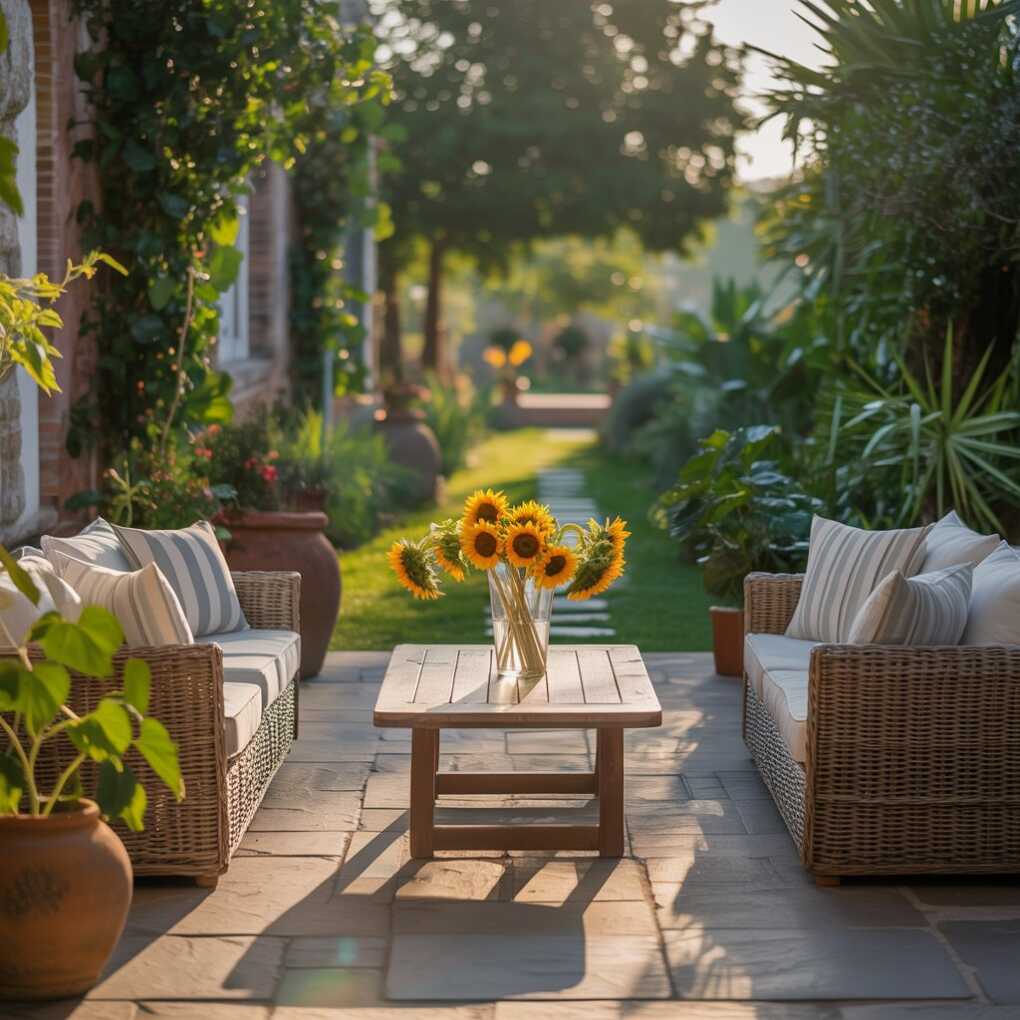
1. Biophilic Design Integration
Biophilic design has emerged as the cornerstone of modern patio aesthetics, creating spaces that foster meaningful connections with nature. This approach goes beyond mere plant placement—it involves thoughtfully incorporating natural elements, textures, and organic shapes that reduce stress while enhancing well-being. By designing your patio to blur boundaries between indoors and outdoors, you’ll create a restorative environment that supports mental health and elevates everyday experiences.
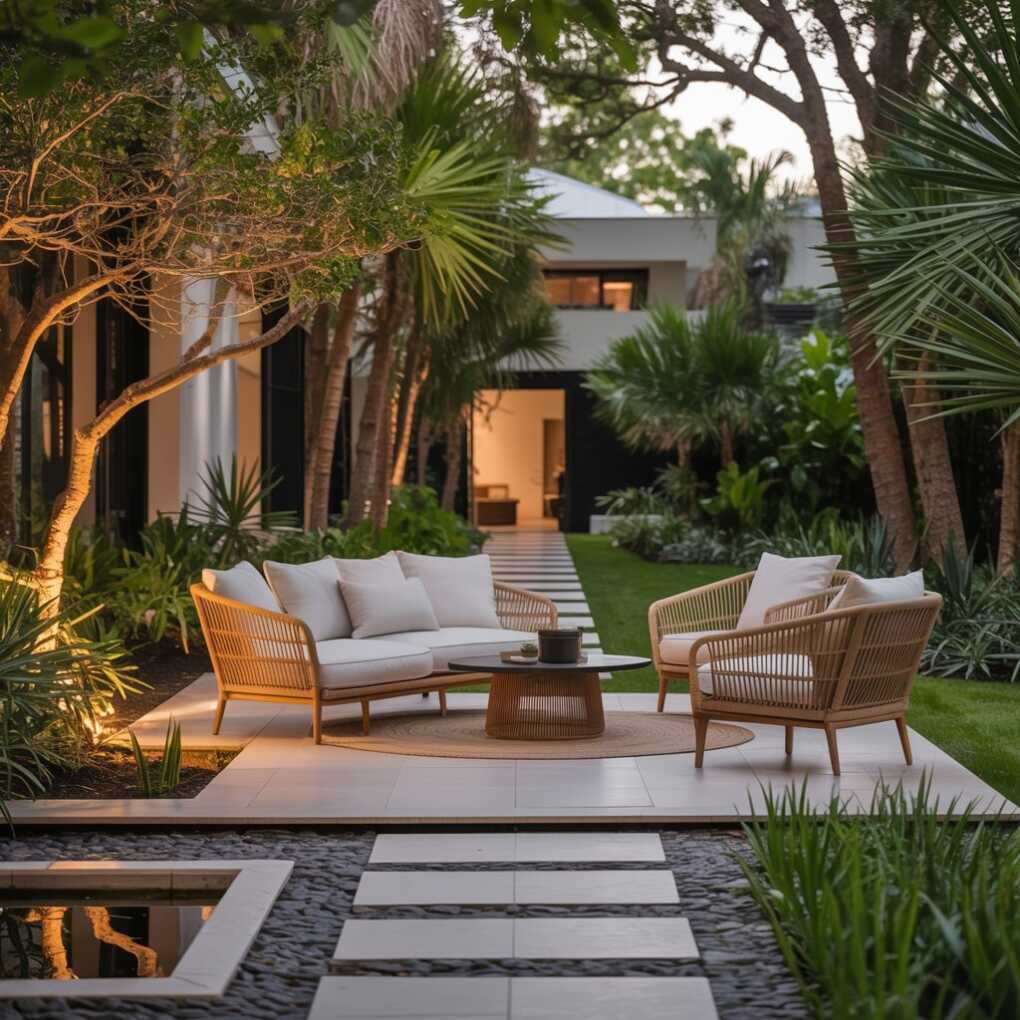
Strategically position your seating to frame natural views, integrate flowing water features that create soothing background sounds, and select furniture that follows organic forms rather than rigid geometries. Plant native species in containers and ground plantings to attract local wildlife while reducing maintenance needs. As interior designer Katarina Skipic notes, “The emphasis is on creating a sanctuary that mirrors the home’s interior style while offering a unique outdoor experience” Decorilla.com.
Pro Tip: Position seating in a semicircle facing your garden rather than your house to maintain the illusion of being immersed in nature rather than looking at it from a distance.
2. Sustainable Material Selection
Eco-conscious homeowners are increasingly prioritizing materials that minimize environmental impact while maximizing aesthetic appeal. Recycled wood, bamboo, and composite decking have surged in popularity for 2025, offering luxurious finishes without compromising environmental values Decorilla.com. These materials not only reduce your carbon footprint but frequently require less maintenance than traditional options, making them practical as well as ethical choices.
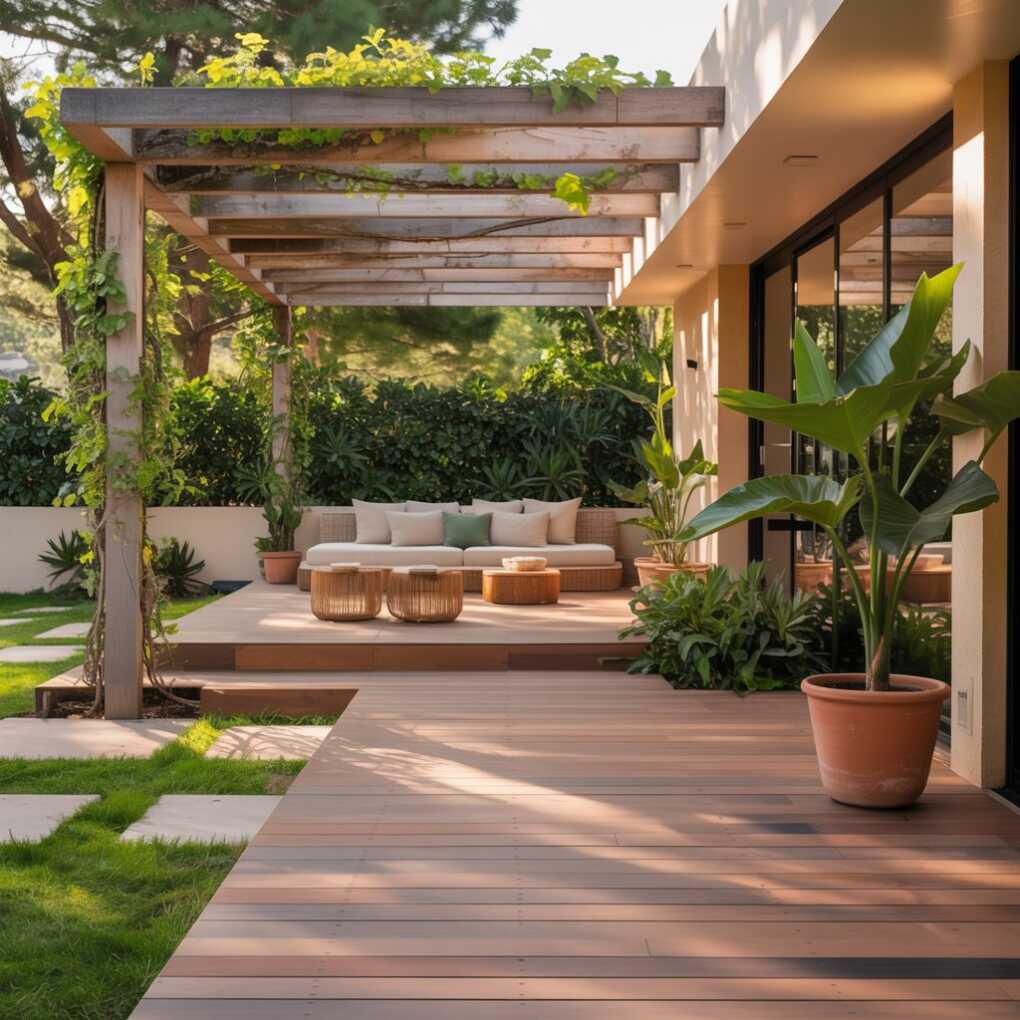
Consider reclaimed timber for structural elements like pergolas or seating frames, which adds character while preventing usable wood from ending up in landfills. Composite decking made from recycled plastics and wood fibers provides the warmth of natural wood without splintering, warping, or requiring regular staining. For pathways between patio areas, permeable pavers allow rainwater to filter naturally into the ground rather than running off into storm drains.
Pro Tip: When selecting reclaimed wood, request documentation about its origin to ensure it hasn’t been treated with harmful chemicals that could leach into your soil or affect plant life.
3. Outdoor Living Room Concept
Treating your patio as an extension of your indoor living space creates seamless transitions that expand your home’s usable square footage. By mirroring your interior design aesthetic outdoors, you establish visual continuity that makes movement between spaces feel intuitive rather than disruptive. This approach transforms what was once merely a transition area into a fully functional living environment where you can relax, entertain, or simply enjoy your morning coffee.
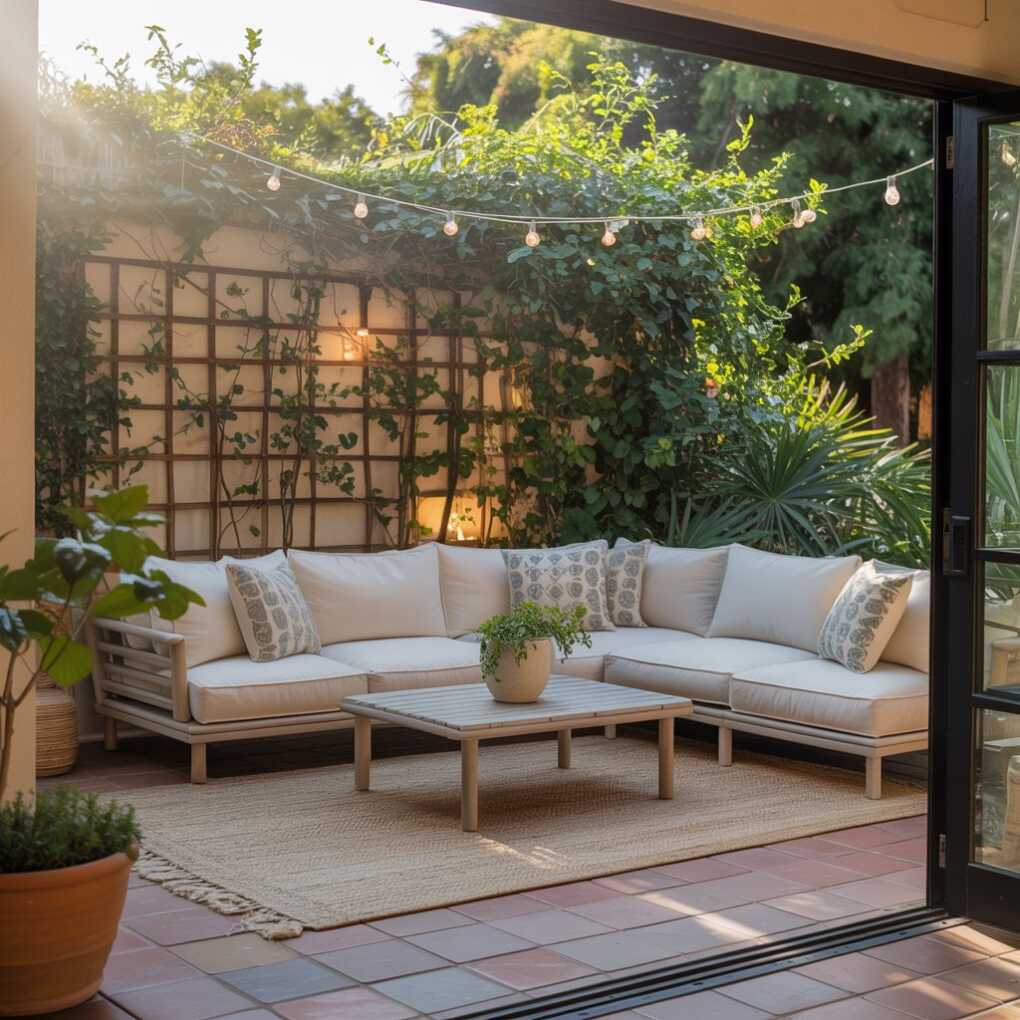
Key to this concept is establishing clear zones within your patio that correspond to functions inside your home—conversation areas with seating arrangements that encourage connection, defined dining spaces with appropriately scaled furniture, and even dedicated reading nooks with comfortable seating and proper lighting. Invest in weather-resistant versions of your favorite indoor furniture styles, and carry through your home’s color palette using textiles, accessories, and finishes that complement both environments.
Pro Tip: Match your outdoor rug pattern or color to an indoor area rug visible from your patio to create subconscious visual continuity between spaces.
| Material Type | Best For | Maintenance Needs | Cost Range |
|---|---|---|---|
| All-Weather Wicker | Seating, Coffee Tables | Wipe clean | $$ |
| Powder-Coated Metal | Dining Sets, Lounge Chairs | Occasional wiping | $$$ |
| Teak | Dining Tables, Lounge Furniture | Oil periodically | $$$$ |
| Textilene | Chair Cushions, Sofa Covers | Hose off regularly | $$ |
4. Seasonal Decor Rotation
One of my favorite patio strategies involves creating flexible design frameworks that accommodate seasonal transformations without requiring complete overhauls. Swapping out throw pillows, small décor items, or even your outdoor rug between seasons keeps your space feeling fresh and interesting without breaking the bank ShelterLogic.com. This approach allows you to celebrate each season’s unique beauty while maintaining a consistent design foundation.
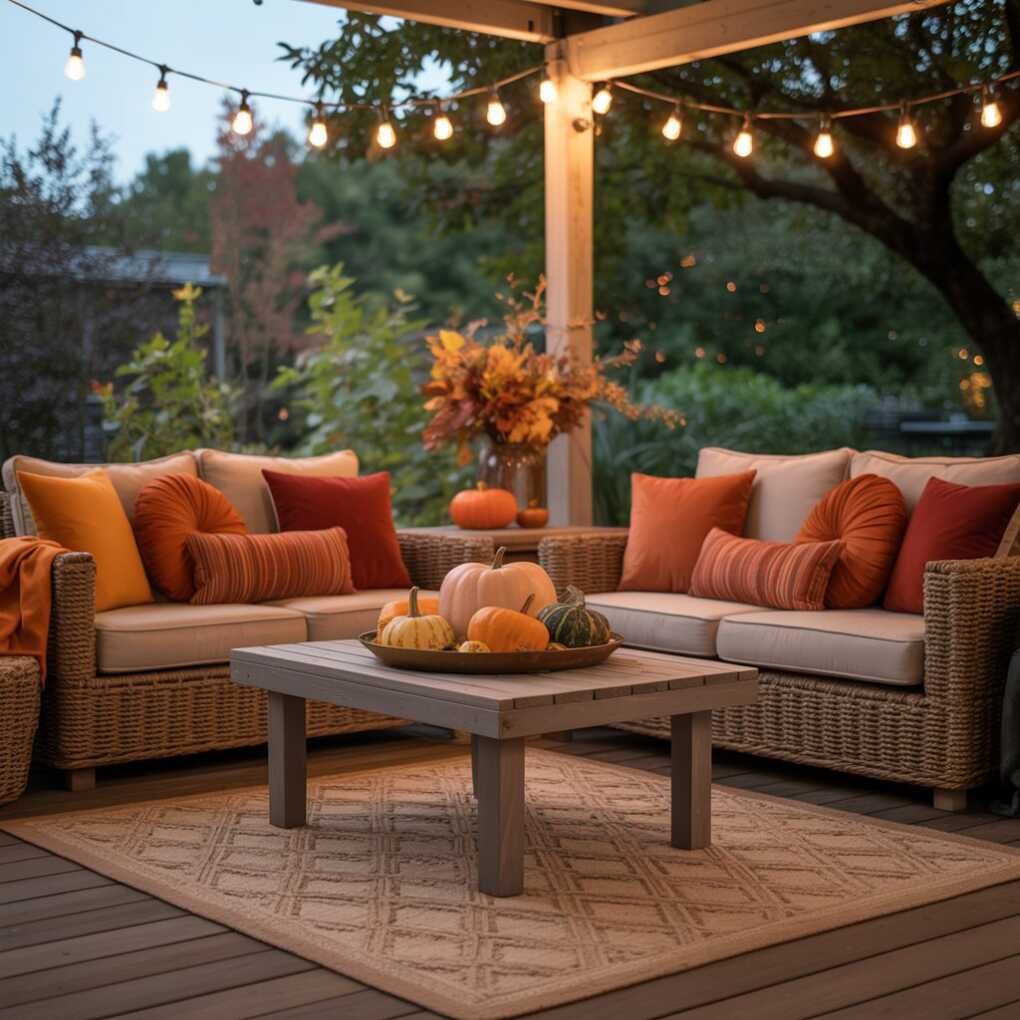
In spring, incorporate pastel cushions, fresh floral arrangements, and lightweight throws. Summer calls for vibrant colors, breathable fabrics, and refreshing water features. Autumn offers opportunities for warm tones, cozy textures with plush blankets, and natural elements like pumpkins and gourds ShelterLogic.com. Winter transformations might include heavier outdoor-rated fabrics, strategic lighting for longer evenings, and heat sources to extend usability.
Pro Tip: Store off-season items in waterproof labeled bins to keep them organized and protected—consider using collapsible storage that can be tucked away when not in seasonal rotation.
5. Cozy Fire Pit Lounge
Fire pits have evolved beyond basic concrete rings into sophisticated design features that serve as both functional heat sources and visual focal points. Position your fire feature as the centerpiece of a conversation area with seating arranged to facilitate easy interaction among guests. Surround the pit with weather-resistant seating that encourages gathering without crowding the heat source—opt for deep, comfortable chairs with ottomans rather than hard benches.
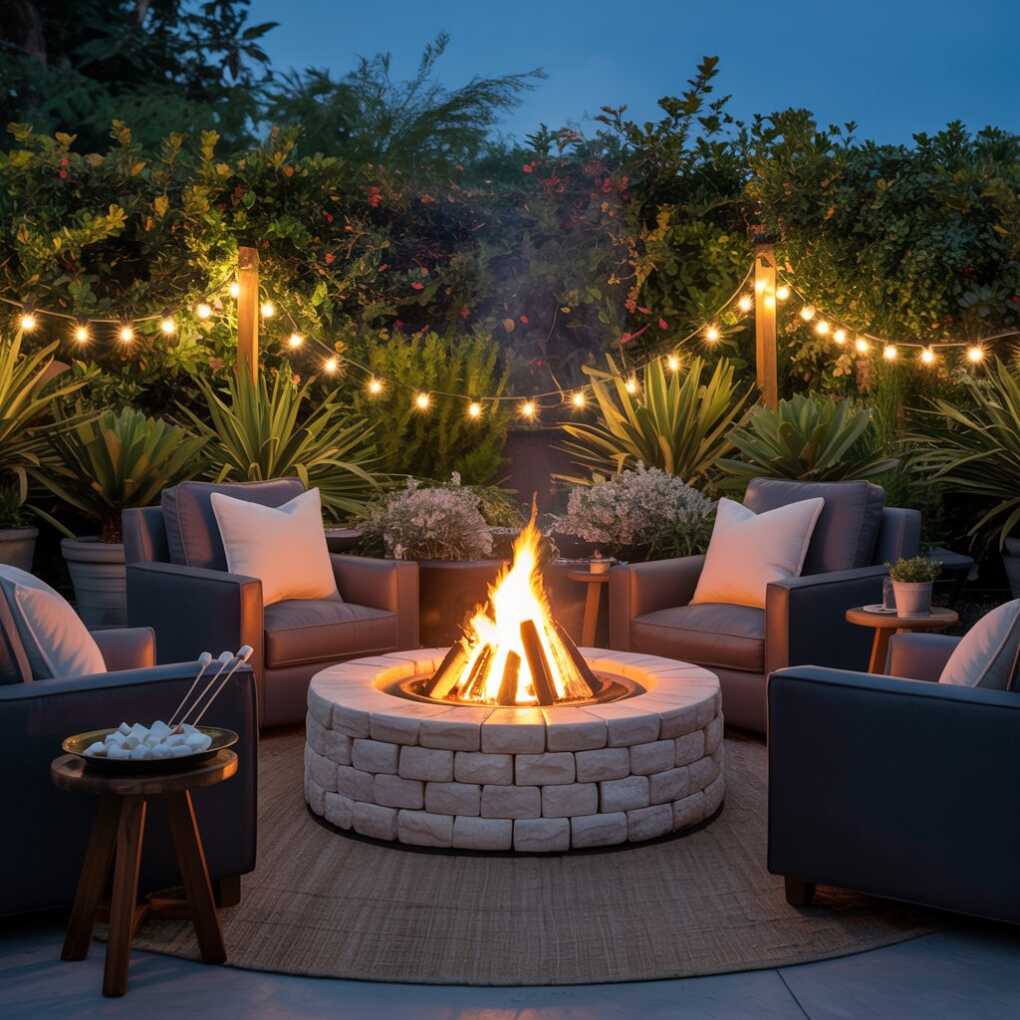
For safety and comfort, maintain at least 7 feet of clearance between the fire feature and any structures or overhanging branches. Choose between wood-burning pits for traditional ambiance or gas-powered alternatives for cleaner operation and easier temperature control. Enhance the area with low-level accent lighting to complement the fire’s glow without overwhelming it, and incorporate windbreaks to prevent smoke from disturbing your gathering.
“Fire features have become essential elements in creating year-round outdoor living experiences. They’re no longer just for cold weather but serve as gathering points that transform patio spaces day and night.” — Industry Expert
Pro Tip: Add a hidden storage bench near your fire pit containing extra blankets, marshmallow roasting sticks, and a fire extinguisher for both convenience and safety.
6. Alfresco Dining Area
Creating a dedicated outdoor dining space elevates everyday meals into special occasions and transforms casual dinners into memorable experiences. Choose a table size appropriate for regular use rather than occasional entertaining—most homeowners overestimate how often they’ll host large gatherings. Opt for materials that withstand weather while complementing your home’s architecture, such as powder-coated metal for modern homes or natural stone for Mediterranean styles.
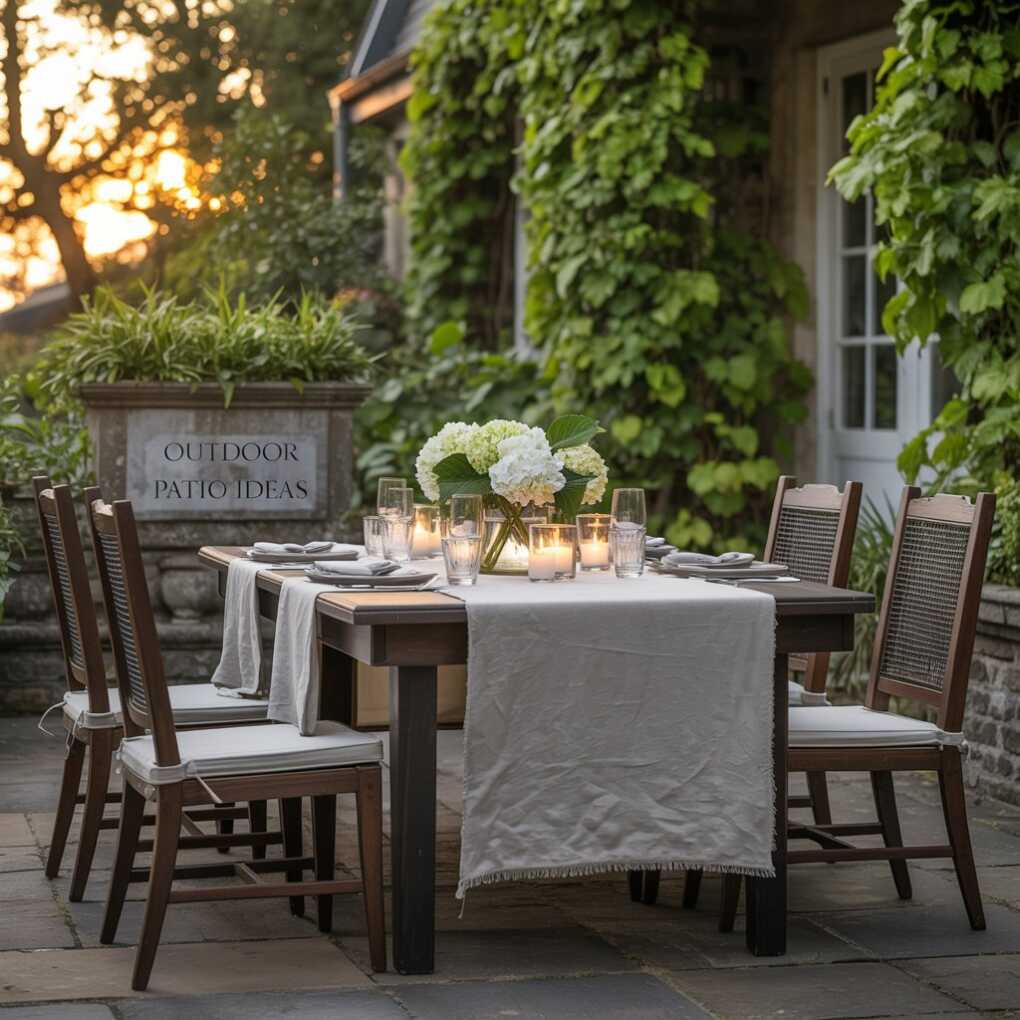
Enhance your dining experience with proper lighting that creates ambiance without causing glare during meals. String lights overhead or wall-mounted lanterns at eye level work better than downward-facing spotlights that create harsh shadows. Incorporate elements like a nearby beverage station or accessible storage for table linens and serving pieces to streamline meal preparation and service.
Pro Tip: Install a narrow rolling cart specifically for outdoor dining that can be stored against a wall when not in use but provides convenient serving space during meals.
7. Outdoor Kitchen Expansion
Full outdoor kitchens have moved from luxury status to practical necessity for many homeowners, particularly those who entertain regularly. The most functional designs follow the same workflow principles as indoor kitchens—create a logical progression from food storage to preparation to cooking to serving. Position your grill at a comfortable working height with adequate counter space on both sides for prep and plating.
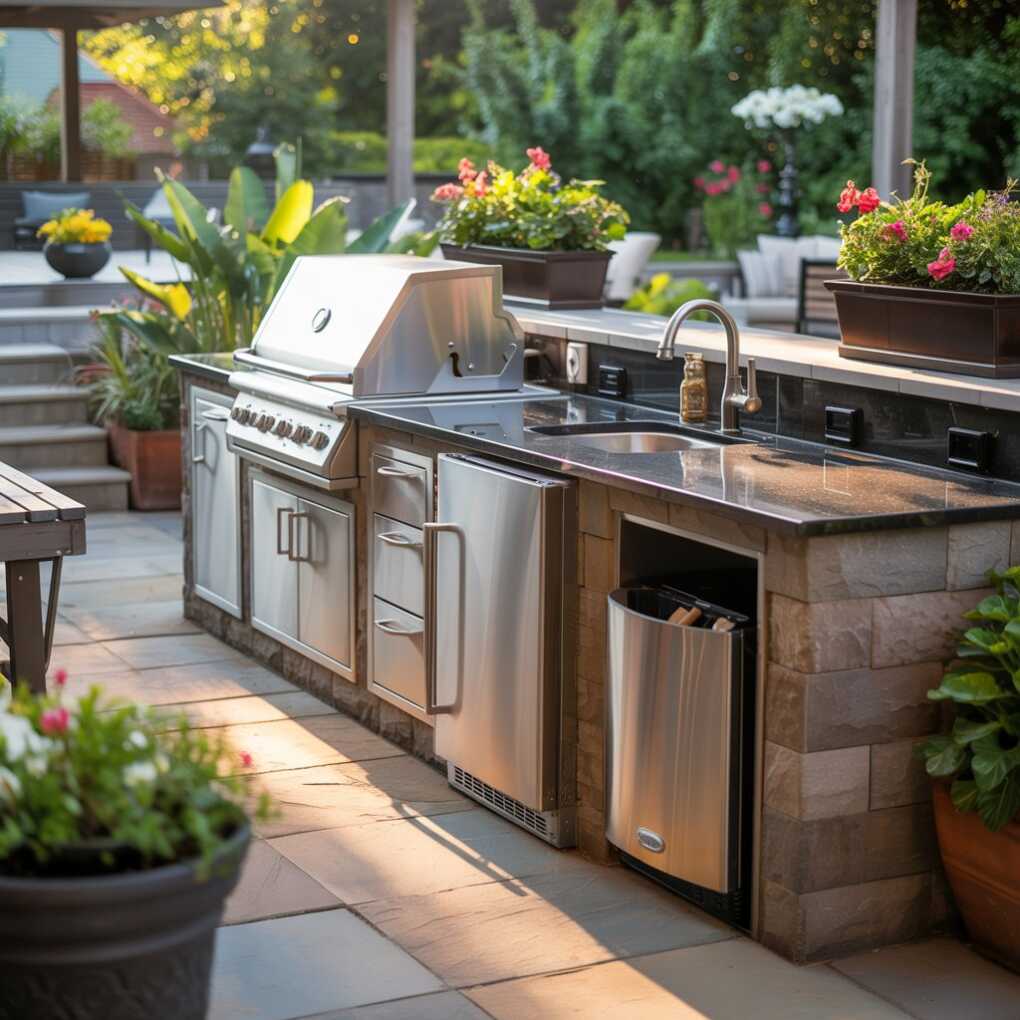
Include essential elements like a sink with hot and cold water, refrigeration for beverages and perishables, ample storage for cooking tools, and proper ventilation. Don’t overlook electrical outlets for small appliances like blenders or coffee makers. For those on a budget, start with a grill station and expand incrementally as needs and resources allow.
Pro Tip: Install a pull-out trash and recycling bin system near your food preparation area to keep your outdoor kitchen tidy during meal prep and cleanup.
8. Relaxation Zen Zone
Carve out a dedicated area solely for relaxation and mindfulness away from the functional zones of your patio. This space should feel distinctly separate, perhaps through changes in elevation, different flooring materials, or strategic plant placement that creates visual privacy. Incorporate elements that engage multiple senses—soothing water features, aromatic plants, comfortable seating, and gentle lighting.

Choose minimalist furnishings that don’t compete for attention, focusing on pieces that encourage proper posture for meditation or comfortable lounging. Consider adding a small fountain or wind chimes that create calming background noise to mask urban sounds. The goal is creating a sanctuary where digital distractions fade away and connection with the present moment takes precedence.
Pro Tip: Position your zen zone to capture morning sunlight for energizing early meditation sessions or afternoon shade for relaxing evening wind-down periods, depending on your personal routine.
9. Multi-Level Patio Design
Dynamic elevation changes create visual interest and help define different functional zones within a single outdoor space. Stepped levels can separate dining areas from lounging spaces, create natural transitions between house and landscape, or accommodate sloping terrain that would otherwise limit usability. Each level establishes its own character while maintaining visual connection to the whole.
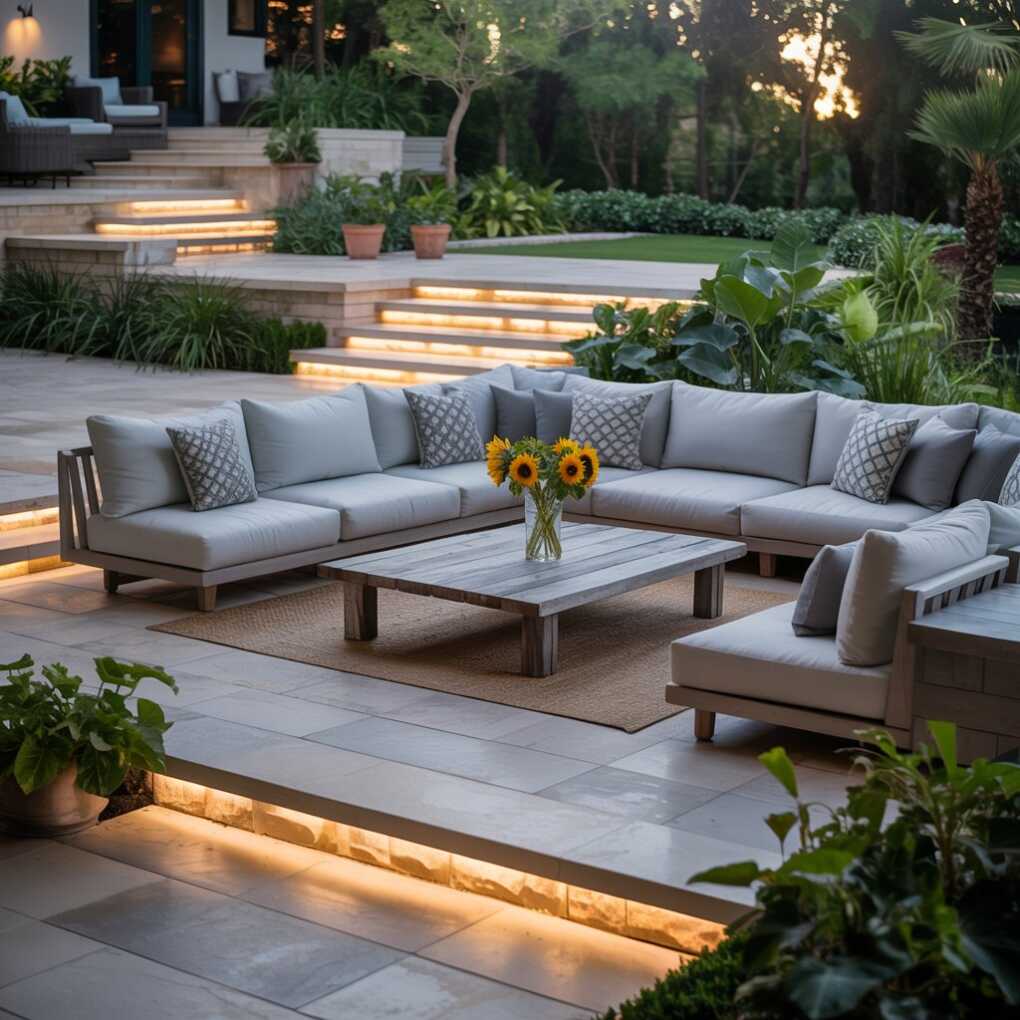
When designing multi-level patios, ensure transitions are both safe and aesthetically pleasing—use consistent materials across levels to create unity while varying textures or colors to distinguish spaces. Incorporate built-in seating along level changes to maximize functionality, and use strategic lighting to highlight transitions for safe nighttime navigation. For accessibility, consider integrating gentle slopes alongside traditional steps.
Pro Tip: Limit your patio to three distinct levels at most—any more risks creating a disjointed experience rather than cohesive flow through your outdoor environment.
10. Natural Material Furniture
Furniture crafted from reclaimed wood, wicker, or wrought iron creates visual warmth while connecting your space to the natural environment Castlery.com. These materials age gracefully over time, developing character that plastic or metal alternatives often lack. When selecting natural material furniture, prioritize quality construction that will withstand local weather conditions while minimizing maintenance requirements.
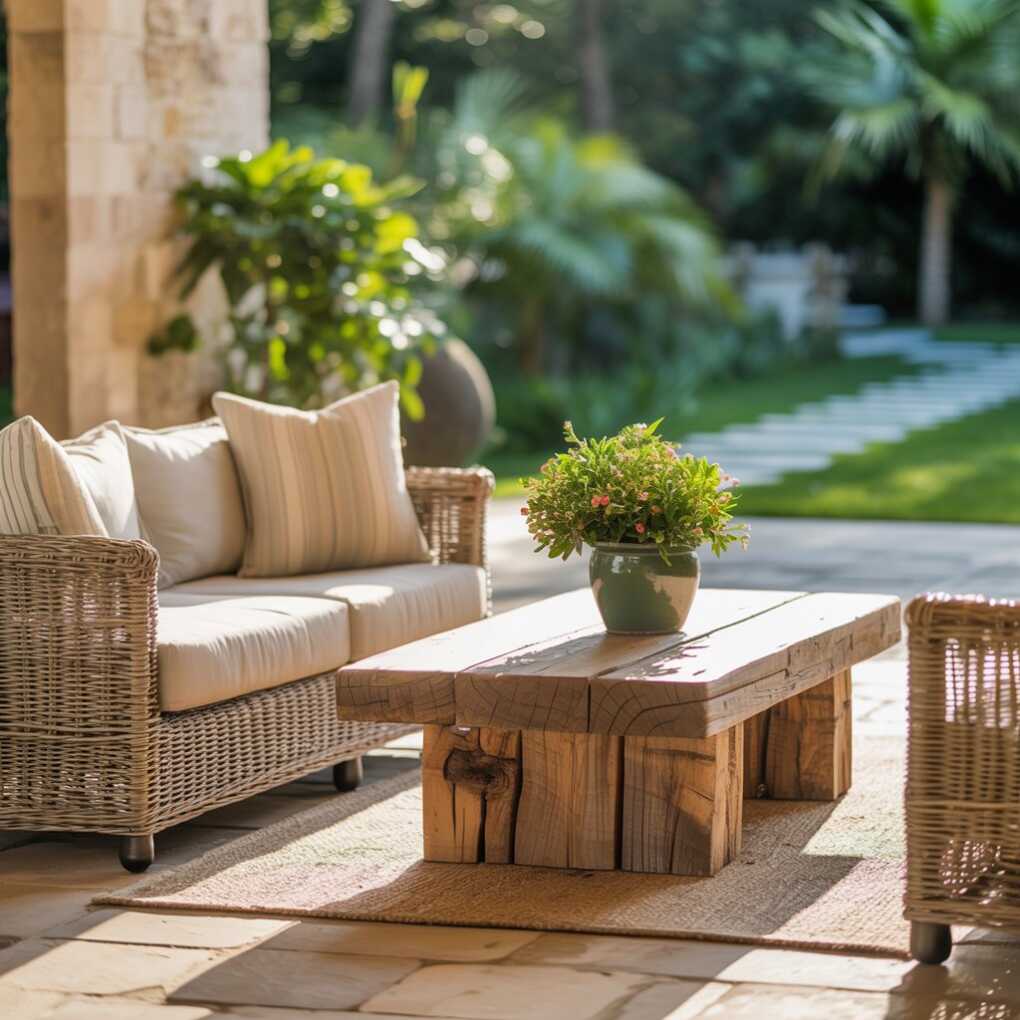
Rattan and wicker offer lightweight flexibility for creating layered looks, while solid wood pieces provide anchor points that ground your design scheme. Mix different natural textures for visual interest—pair smoothly sanded teak with rough-hewn cedar, or combine smooth stone tabletops with woven wicker chairs. These combinations create depth that keeps your space feeling organic and thoughtfully curated rather than matchy-matchy.
Pro Tip: Apply natural wood sealants annually to extend the life of wooden furniture without creating a shiny, artificial appearance that conflicts with your patio’s organic aesthetic.
11. Textile Layering for Comfort
Creating a cozy and inviting atmosphere often comes down to strategic textile layering in earthy hues like warm browns, deep greens, and rusty oranges Castlery.com. Start with durable outdoor fabrics for your primary seating, then layer with weather-resistant throw pillows in varying textures and patterns. Add dimension with lightweight throws folded over chair backs or neatly arranged on storage benches.

Invest in high-quality outdoor rugs that define seating areas while adding comfort underfoot. Consider a rug pad designed for outdoor use to prevent slipping and extend your rug’s lifespan. For dining areas, incorporate placemats and runners that tie into your seasonal decor scheme, changing them along with your pillow and throw selections for a fresh look each season.
Pro Tip: Store extra set of seasonal pillows in decorative outdoor-rated storage that matches your patio furniture—this keeps your current selections looking their best while making seasonal rotation effortless.
12. Statement Lighting Features
Lighting serves both practical and atmospheric purposes in outdoor design, transforming your patio from functional space to magical retreat as daylight fades. Move beyond basic overhead lighting to create layered illumination that guides movement, highlights architectural features, and sets the appropriate mood for different occasions.
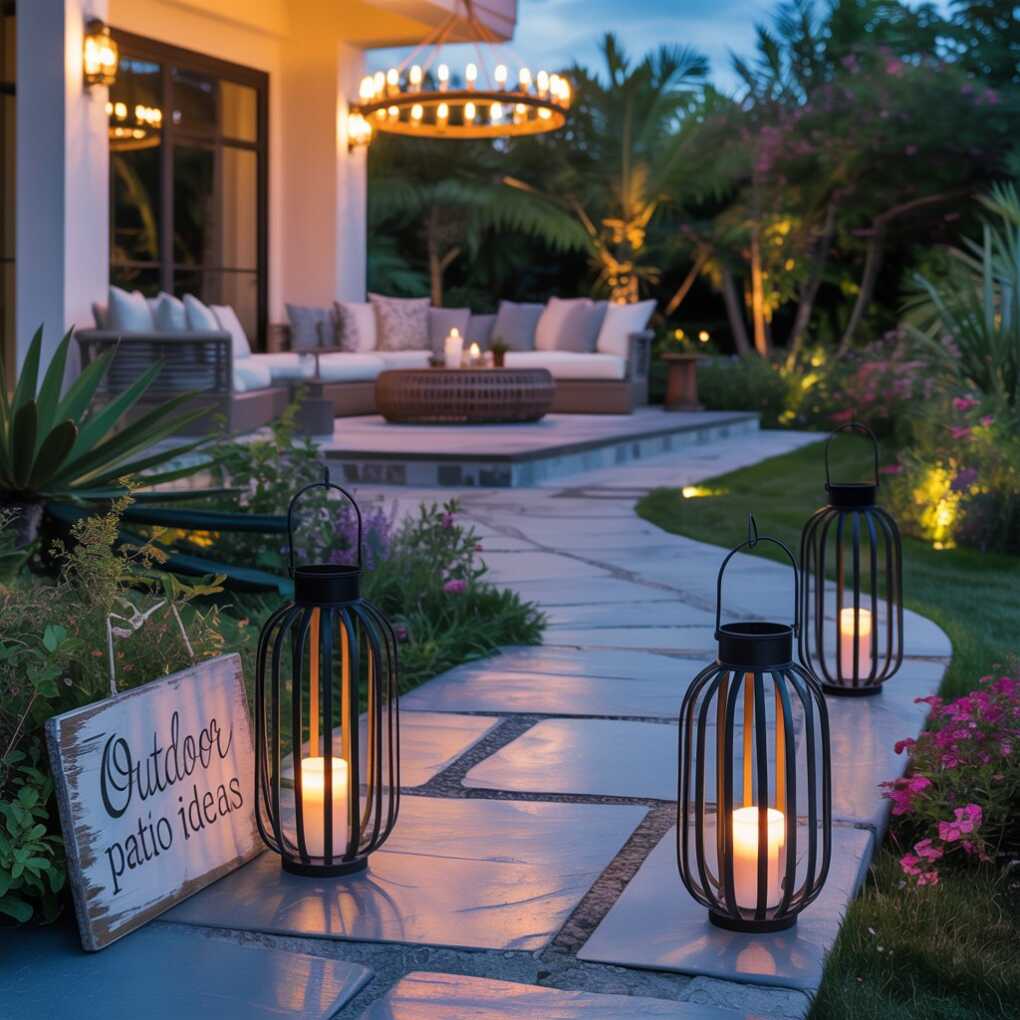
Combine multiple light sources: task lighting for food preparation and dining, ambient lighting for general illumination, and accent lighting to highlight plants, textures, or design features. Solar-powered pathway lights provide safe navigation without electrical wiring, while LED string lights create whimsical overhead canopies. For dramatic effect, incorporate uplighting for trees or building features that creates striking silhouettes against walls.
Pro Tip: Install lighting on dimmer switches or smart controls to allow adjustment for different occasions—from bright illumination for dining to soft glow for evening relaxation.
13. Water Feature Integration
The soothing sound of flowing water creates instant tranquility while masking urban noise pollution that often plagues outdoor spaces. Modern water features range from simple bubbling spheres to elaborate wall-mounted cascades, allowing integration into virtually any patio size or style. Position your water feature where its sound can be heard from primary seating areas without creating excessive moisture on furniture.
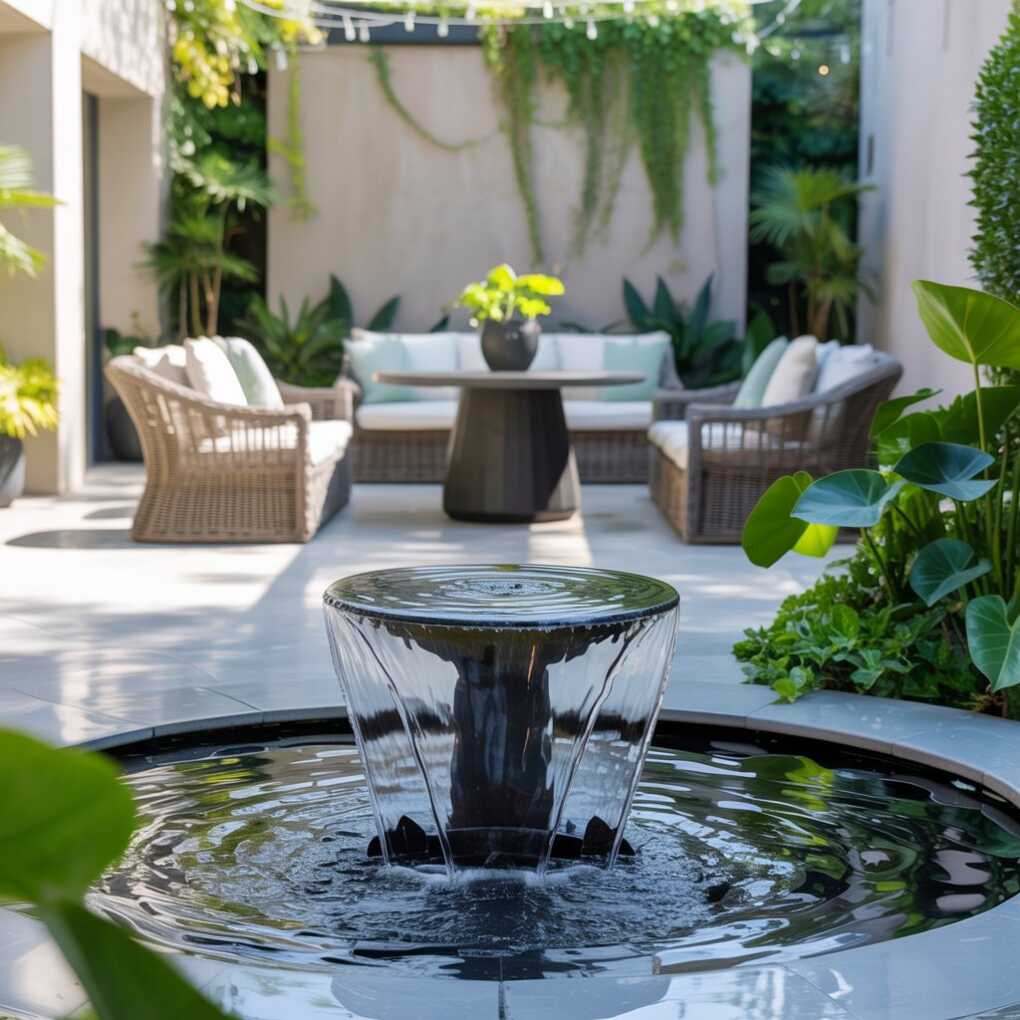
Consider self-contained recirculating systems that minimize water waste while providing the calming benefits of moving water. Incorporate plants around water features to create natural buffers that enhance aesthetics while helping maintain water quality. For smaller spaces, tabletop fountains offer the soothing benefits of water without requiring extensive installation.
Pro Tip: Place your water feature slightly off-center in your patio layout—this creates visual interest while preventing it from dominating the entire space.
14. Outdoor Entertainment Hub
Modern patios increasingly serve as extensions of indoor entertainment spaces, particularly as streaming services and outdoor-rated technology improve. When planning your entertainment zone, consider both visual and audio components that enhance experiences without overwhelming the space. Choose weather-resistant speakers that blend into your landscape rather than dominating it visually.

For viewing areas, consider projector screens that can be hidden when not in use rather than permanent mounted TVs that might detract from the natural ambiance. Ensure your entertainment zone has convenient access to power sources while keeping cords safely tucked away. Add flexible seating that can reconfigure for intimate movie nights or larger game-watching gatherings.
Pro Tip: Install a dedicated subwoofer in a weatherproof enclosure partially buried near your entertainment zone—this delivers rich sound quality without requiring large visible speakers.
15. Vertical Garden Walls
For homeowners with limited square footage, vertical gardening transforms underutilized wall space into living art that enhances privacy while improving air quality. Modular vertical garden systems allow customization to fit your specific space while accommodating a variety of plant types, from herbs for cooking to flowering varieties that attract pollinators.
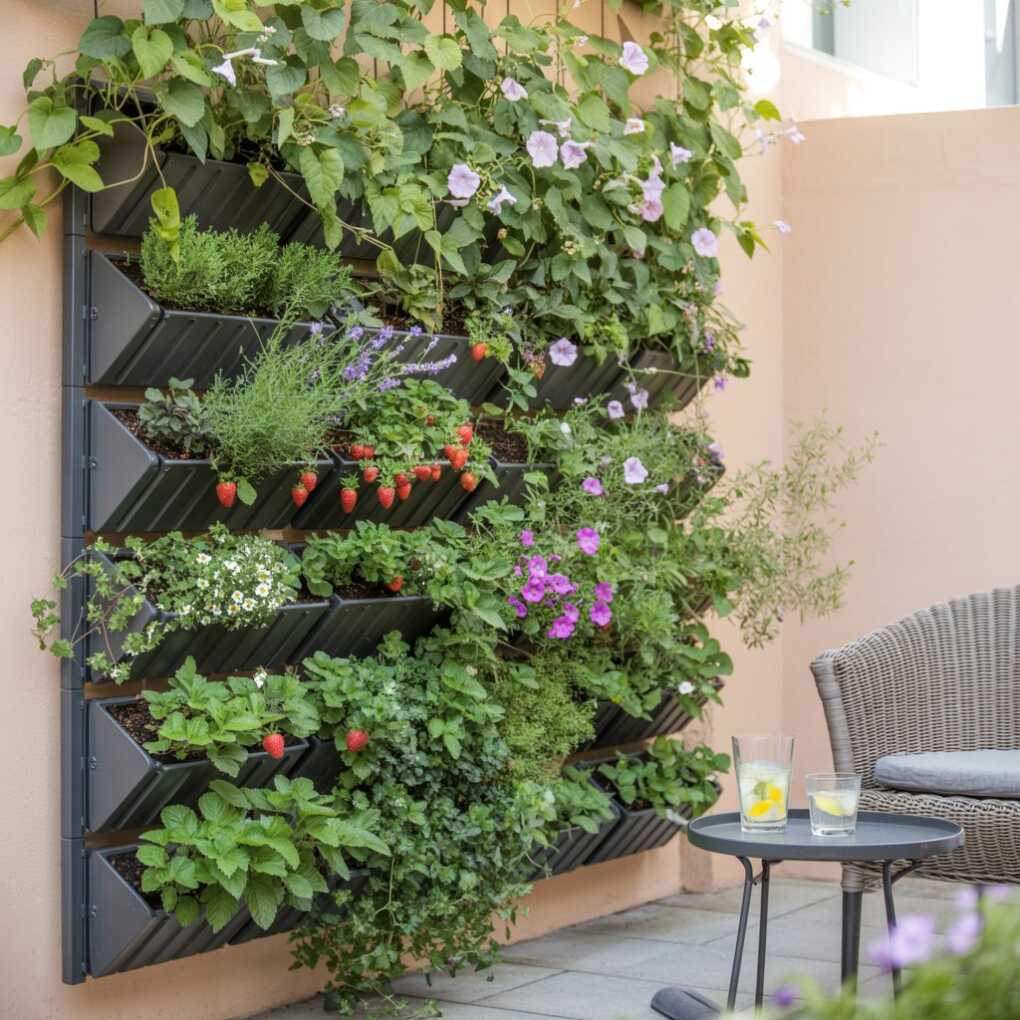
Create visual interest by mixing different plant textures and colors in your vertical garden. Incorporate edibles like herbs and strawberries alongside ornamental plants to maximize functionality. Install proper irrigation systems designed for vertical applications to ensure consistent watering without excessive maintenance. Position vertical gardens to take advantage of existing light conditions—partial shade varieties for north-facing walls, sun-lovers for southern exposures.
Pro Tip: Add tension rods behind your vertical garden system to support climbing plants like morning glories or sweet peas that will spill over the top for added dimension.
16. Pet-Friendly Patio Space
As pets increasingly become family members, designing outdoor spaces that accommodate their needs makes your patio enjoyable for all household members. Create dedicated zones with pet beds elevated off the ground to protect against moisture, and incorporate shaded areas where animals can cool off during hot weather. Include easily accessible water stations and washable surfaces that simplify cleanup after muddy adventures.
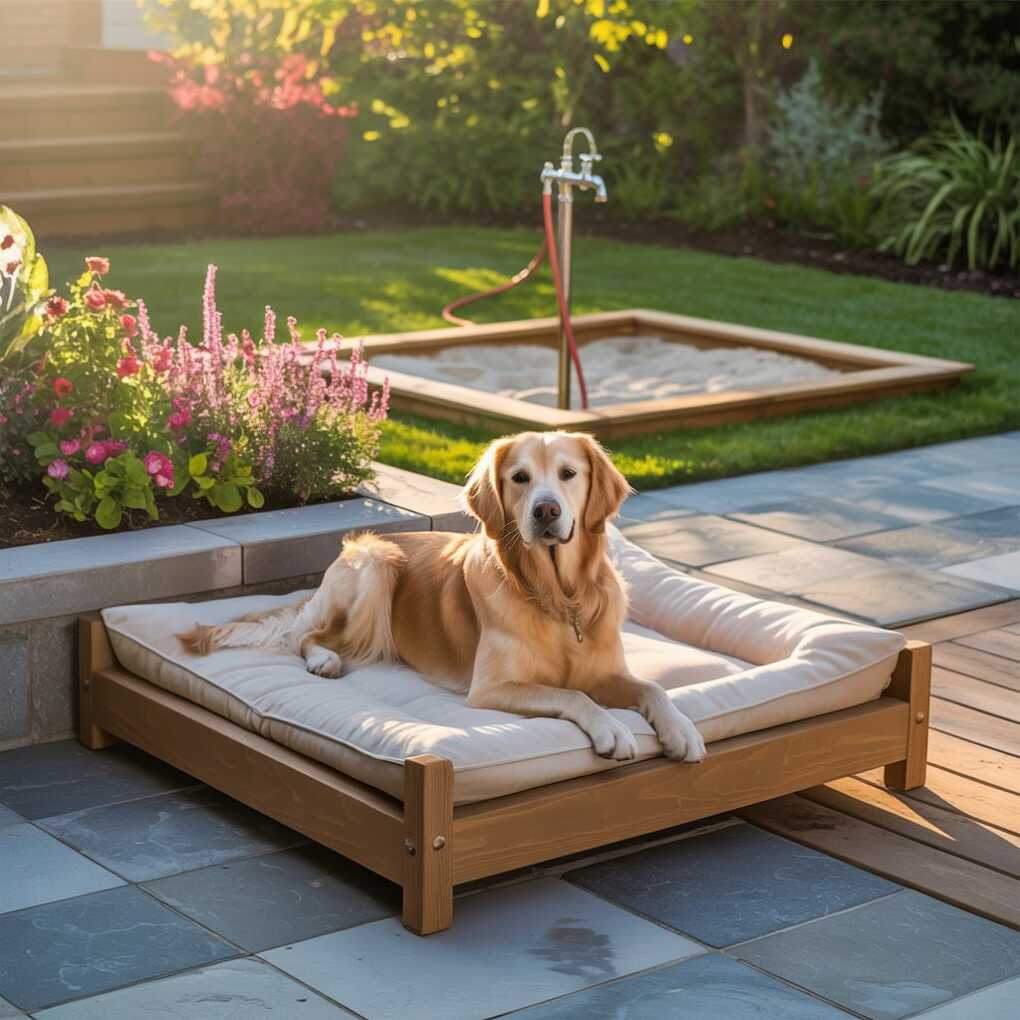
Integrate pet-friendly plants that are non-toxic if chewed, avoiding common hazards like lilies or sago palms. Design clear pathways between functional zones to prevent tripping while carrying armloads of pet supplies. Consider installing a pet washing station near an outdoor faucet for quick cleanups after outdoor play.
Pro Tip: Bury a designated digging zone filled with safe sand where your dog can indulge natural behaviors without destroying your carefully cultivated garden areas.
17. Work-From-Patio Nook
The shift toward flexible work arrangements has created demand for outdoor workspaces that blend productivity with natural inspiration. When designing your work-from-patio area, prioritize consistent electrical access through weather-protected outlets, and invest in glare-reducing screen protectors for digital devices. Create a dedicated desk space with proper ergonomics to prevent strain during extended work sessions.

Position your work nook to capture gentle morning light without creating harsh screen glare, and incorporate privacy screens to prevent visual distractions. Choose furniture with built-in storage for office supplies that can be neatly tucked away when transitioning from work mode to relaxation. Add sound-masking elements like small water features to create a productive atmosphere that minimizes urban noise interference.
Pro Tip: Install a swivel monitor arm that allows you to adjust screen position as the sun moves throughout the day, maintaining optimal visibility regardless of changing light conditions.
18. Color-Themed Seasonal Pallets
Strategic color selection creates emotional resonance that enhances your patio’s atmosphere throughout changing seasons. Move beyond basic neutrals to create intentional color stories that evolve with the calendar—soft pastels for spring renewal, vibrant jewel tones for summer energy, warm earthy palettes for autumn harvest, and crisp monochromatic schemes for winter serenity ShelterLogic.com.
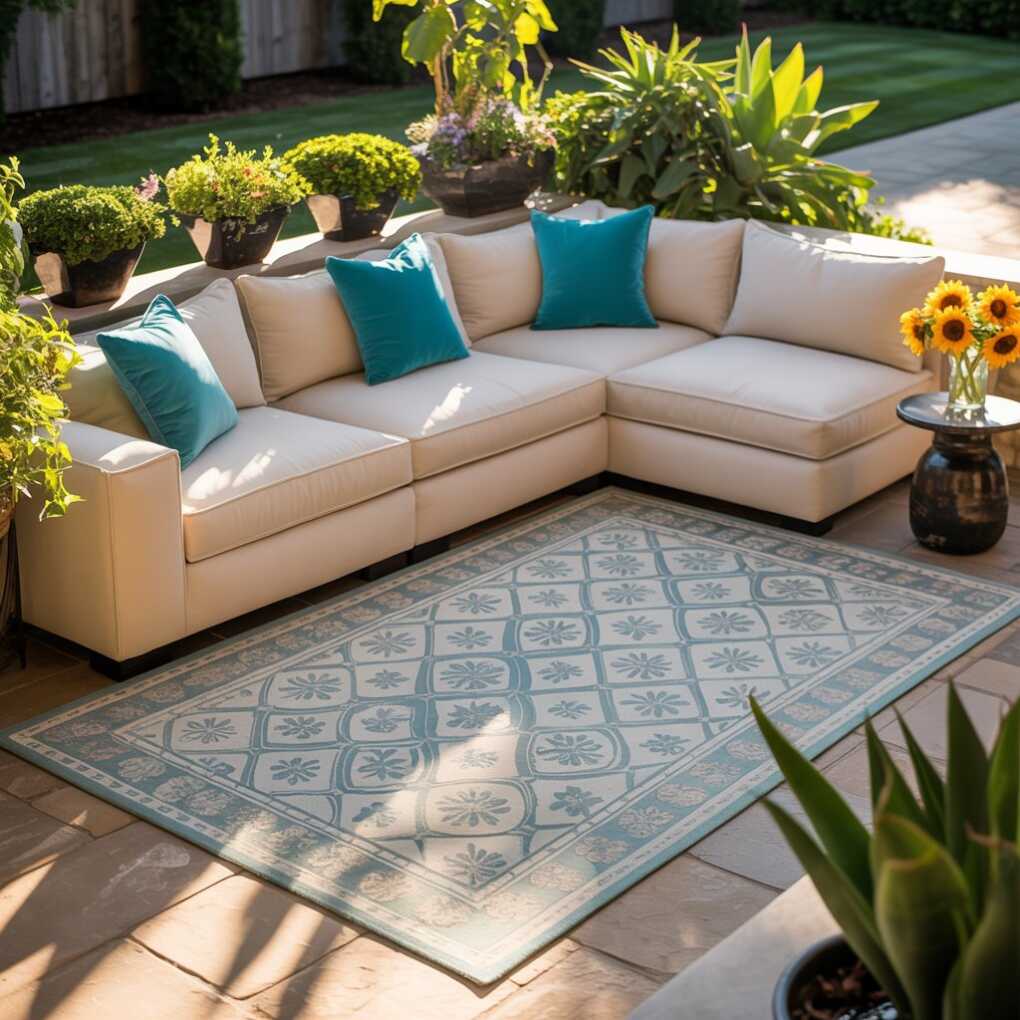
Create cohesion through the 60-30-10 color rule: 60% dominant color (often your base furniture), 30% secondary color (textiles and larger accessories), and 10% accent color (small decor pieces and seasonal touches). Rotate accent pillows, outdoor rugs, and smaller decorative elements to shift your palette between seasons while maintaining underlying continuity.
Pro Tip: Store seasonal accent items in clear, labeled bins stored in nearby weatherproof outdoor storage—this simplifies seasonal transitions while protecting delicate fabrics from sun damage.
19. Personalized Decor Accents
Your patio should reflect your unique personality rather than adhering strictly to trends. Incorporate meaningful objects that tell your story—travel souvenirs repurposed as garden art, family heirlooms adapted for outdoor use, or handmade pieces created by you or loved ones. These personal touches transform generic spaces into authentically “you” environments that feel welcoming and comfortable.
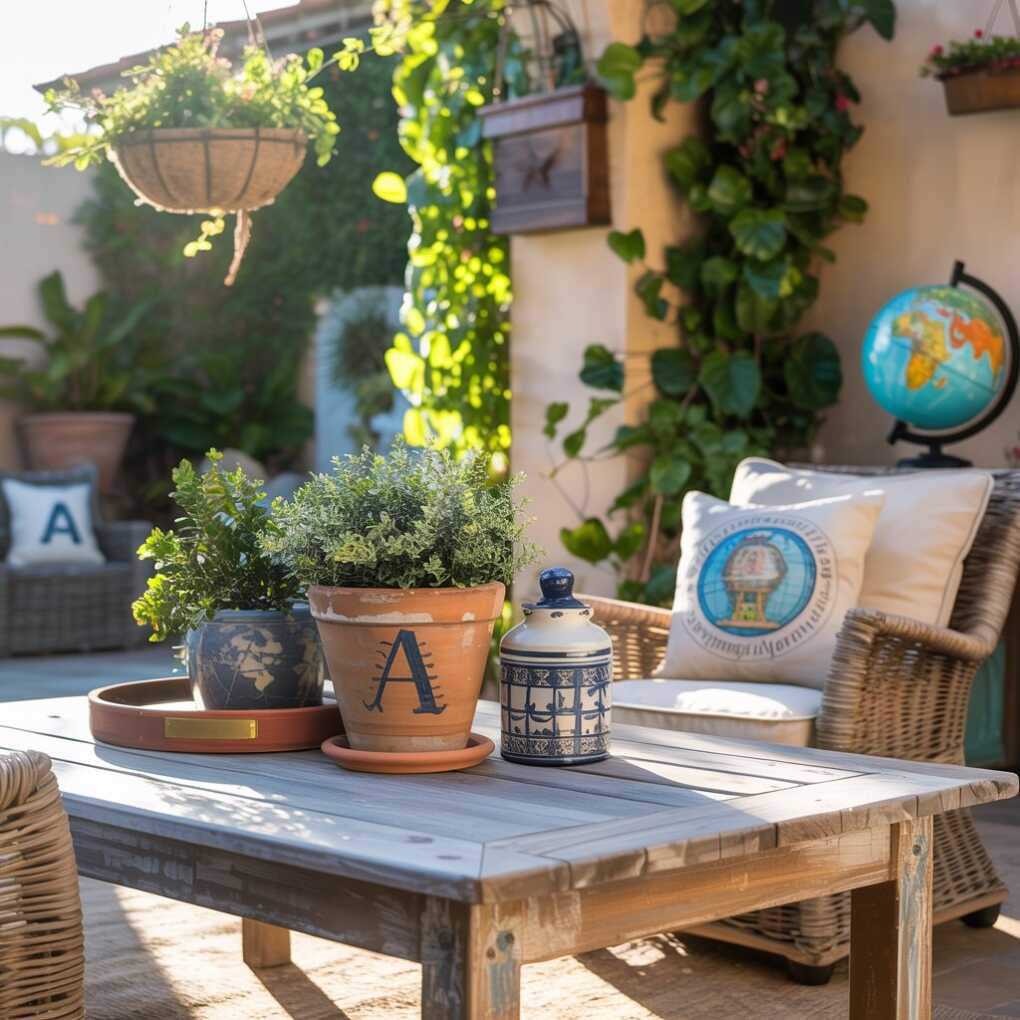
Create focal points with artwork designed specifically for outdoor environments, or protect indoor pieces with UV-filtering glass and strategic placement that minimizes direct sun exposure. Incorporate custom elements like monogrammed cushions, personalized plant markers, or hand-painted pots that add bespoke character without requiring major construction. Remember that personalization works best when it feels organic rather than forced—select items that genuinely resonate with your story.
Pro Tip: Designate one rotating display area where you can feature different personal items throughout the year—this keeps your space feeling fresh while providing an ever-changing conversation starter.
20. Smart Technology Integration
Modern patio design increasingly incorporates intelligent technology that enhances convenience without compromising natural aesthetics. Smart irrigation systems adjust watering schedules based on local weather conditions, while automated lighting systems can be programmed to create gradual sunrise/sunset effects. Weatherproof speakers controlled through voice assistants allow seamless music integration without visible hardware.

Consider installing smart fire pits that can be controlled remotely, adjusting flame height and duration through your smartphone. Automated shade systems respond to sun position and temperature, creating comfortable environments without manual adjustment. For security-conscious homeowners, integrated outdoor surveillance systems blend into landscaping while providing peace of mind.
“Smart outdoor technology should enhance the experience rather than dominate it—focus on systems that operate seamlessly in the background rather than becoming the primary focus of your outdoor space.” — Home Automation Specialist
Pro Tip: Install power outlets with USB ports integrated throughout your patio design—this provides convenient charging for devices while keeping cords neatly managed through strategic placement.
Final Thoughts
As we’ve explored these 20 outdoor patio ideas, remember that your perfect patio evolves with your lifestyle rather than requiring a single massive investment. Start with one or two elements that address your most pressing needs, then gradually build your ideal outdoor sanctuary over time. For Houston residents seeking professional guidance, Smart Remodeling offers stress-free patio renovation services that transform visions into reality.
Whether you’re creating a serene retreat for personal relaxation or designing an entertainment hub for family gatherings, the most successful patios authentically reflect their owners while seamlessly connecting indoor and outdoor living. By incorporating these proven strategies, you’ll create an outdoor space that not only enhances your home’s value but becomes the heart of your everyday living experience—a true sanctuary where memories are made and shared throughout the seasons.
